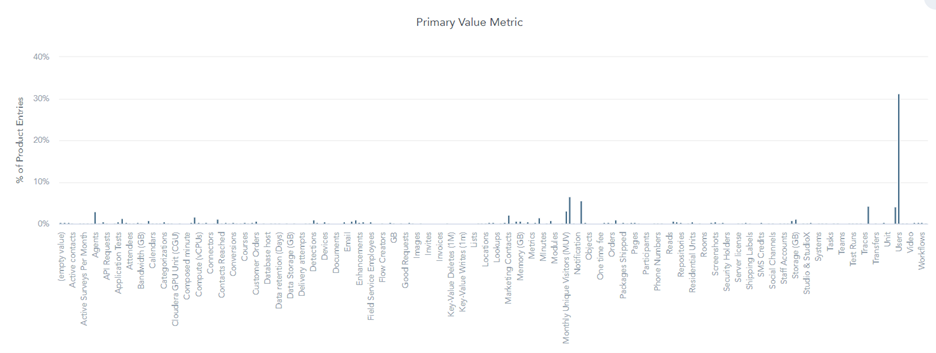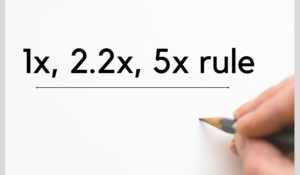Analyzing pricing models is often a good first step in analyzing value metrics for SaaS offerings
May 2022
Author: Bryan Belanger
May 2022
Author: Bryan Belanger

Value metrics are often discussed as the key foundation of an effective SaaS pricing strategy. Value metrics are a way of characterizing the unit economics of a given product, and thus outlining how that product scales with usage. To illustrate, let’s use a simple non-SaaS example: driving ranges. I’m not an avid golfer, but most of my immediate family is and I enjoy a good trip to the driving range. If you go to a driving range to hit golf balls, you pay a single fee for a defined number of golf balls to hit — maybe you get 50, 100 or more. In this example, golf balls are the value metric that defines the offering.
In theory, value metrics also define how products are priced to buyers. Importantly, however, this is not always the case. Revisiting the example above, I don’t pay per golf ball at the driving range, and I don’t get to specify a quantity of golf balls I want to hit. It’s more likely that I pay something like $10 for a fixed volume of 50 golf balls. The pricing model is a fixed flat fee, and the packaging model of the offering is tiered, with the tiers defined based on a fixed allotment of golf balls.
We often think of value metrics as part of something we call “usage factors,” which is the entire constellation of factors related to usage of a given software product and edition. For example, a BI dashboarding product might have a Starter plan that allots a certain number of users, gigabytes of storage, workspaces and saved dashboards to the customer. These four factors would all be considered usage factors in our nomenclature. Identifying which one of these usage factors is the value metric is a bit more complicated. If the product is priced by any one of these factors (e.g., $10 per user), then it’s easy — that factor is the value metric. However, if the product is priced as a flat fee (e.g., $500 per month for the Enterprise plan) or priced with multiple pricing models, then determining which factor is the value metric becomes harder.
When things get complex in SaaS pricing, as they often do, we look at market data to help provide us with answers.
We previously wrote about our confusion with much of the marketing content that is currently out there about SaaS pricing models and offered our version of a simplified taxonomy in our definitive SaaS pricing models guide. That taxonomy is also a helpful construct for understanding value metrics.
Analyzing pricing models is often a good first step in analyzing value metrics for SaaS offerings. We define four major categories of pricing model for SaaS offerings: Per-user, Flat-fee, Usage-based and Hybrid. For per-user pricing models, the value metric is simply “users” — this is how the product is priced, and how usage and value scale (whether or not users are a good value metric is a separate concern, and something we explore in the next section). The same is true of usage-based models — with a usage-based pricing model, the product is priced to the customer based on one or more usage factors. It might be per gigabyte, per active row, per database or per meeting invite, just to name a few examples. With these models, the pricing model is also a signifier of the value metric.
These scenarios represent just under 60% of the products we currently have in our XaaS Pricing database.
Where things get more complex is in the remaining 40% of scenarios, in which products are packaged with a tiered strategy and pricing is based on a flat monthly or annual fee.
In these scenarios, the value metric must be identified by evaluating the features and usage limits of a given product and edition. In some cases, vendors make the primary value metric clear with how their plans are presented to customers. In other instances, the presentation of the plans makes it more difficult to identify the value metric, and/or there is no singular identifiable value metric. For example, Zapier makes it pretty clear on its pricing page that tasks are its primary value metric, since it offers a drop-down menu that displays exactly how pricing scales with additional tasks. In other cases, such as with ClickUp, there are multiple usage metrics (we count over 20 across ClickUp plans, and they highlight five that are the main ones), and it’s not completely clear which is the primary value metric. In these instances, you have to make an educated guess on which of these usage factors represents the primary value metric that underpins the offering.
This is a straightforward task but not an easy one. Looking across our XaaS Pricing database, there is a vast array of different value metrics that SaaS companies use to define their offerings:

This complexity, both across the industry as well as within the specific context of the packaging and pricing strategy of any given vendor, leads to a simple question: “Where do we even start with establishing a value metric for our product?”
This is a question that is relevant to us not only because it’s an evergreen question in SaaS pricing but also because it’s something we’re also constantly evaluating for our XaaS Pricing product. We’ve both analyzed this question and lived this question with our own product.
While most analysts and pricing strategy advisers in SaaS talk about value metrics as a separate and distinct element of your pricing strategy that you need to figure out, we view value metrics as the intersection of an effective pricing and packaging strategy. With packaging, you determine what you will offer to the customer. This includes how you will structure your offering — whether you will offer tiered editions (which most do), and if so, how those editions will be structured in terms of features and usage allotments.
In conjunction with determining “what” you will offer with packaging, you concurrently must determine pricing strategy, which is where you establish “how” you will offer your product and packages to the customer. This includes how you will charge the customer for those packages, and how much you will charge, based on an understanding of the market you operate in and customer willingness to pay.
If you use this type of framework, the value metric simply becomes the derivative of those conjoined decisions on packaging and pricing. It’s conceptually fairly straightforward. But where it gets complex is that you have a diversity of choices — you may have settled on three packages for your product and roughed out five key usage factors, but you’re unsure whether you should charge for the product based on users or use a flat-fee model and allow for a defined number of users within each tier.
With that in mind, below we offer some guidelines for those just getting started with these types of product and packaging decisions:
Value metrics feel complex but are straightforward. Ultimately, having a clear value metric really just comes down to having a transparent pricing and packaging strategy. If the pricing model and the usage factors that define how a product scales are clear, the value metric is simply the primary usage factor.
 ©2022 XaaS Pricing. All rights reserved. Terms of Service | Website Maintained by Tidal Media Group
©2022 XaaS Pricing. All rights reserved. Terms of Service | Website Maintained by Tidal Media Group

 SaaS pricing and the ‘1x, 2.2x, 5x’ rule
SaaS pricing and the ‘1x, 2.2x, 5x’ rule